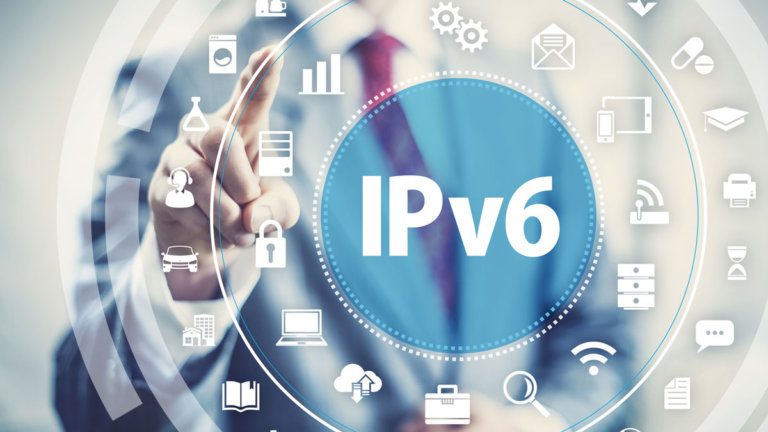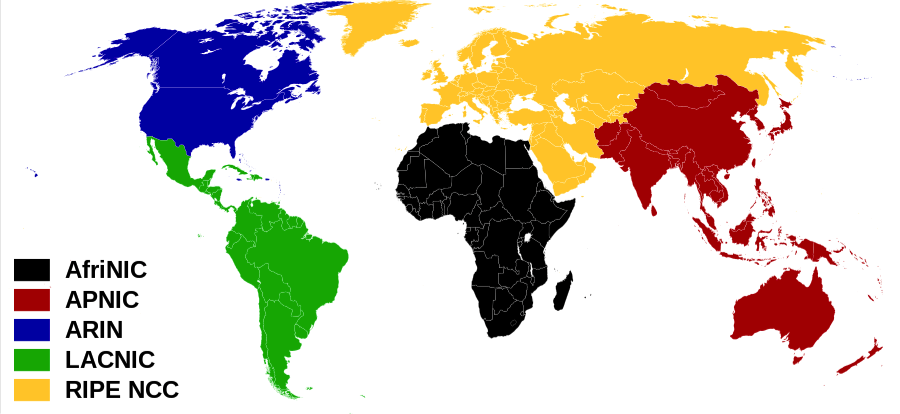Data
Good-Bye IPv4, Hello IPv6

ARIN just ran out of IPv4 addresses!
News sources are abuzz that ARIN has finally ran out of IP addresses. Let’s take a look at the implications.
Q: What is ARIN?
A: ARIN is the American Registry of Internet Numbers serving North America and is one of five official entities that can issue IPv4 addresses to Internet Service Providers, government agencies, enterprises and small companies. There are only five of these issuing entities that serve the entire world – and here is a map, showing the areas served:
Figure 1 Taken from Wikipedia – https://en.wikipedia.org/wiki/Regional_Internet_registry
Four of the five Regional Internet Registries (RIRs) have exhausted their pools of IPv4 addresses, meaning that it will become increasingly difficult for Internet Service Providers to acquire additional IPv4 addresses to support growth in subscribers, services, and devices.
Q: So, how does a lack of IPv4 addresses affect me as an ordinary person?
A: Every device that communicates over the Internet has been using an IPv4 IP address for messages, music, videos, and tweets. Home Wi-Fi routers, computers, laptops, smart phones and tablets all need an IP address, and now, home security systems, home automation systems, home entertainment systems, smart thermostats, smart locks, smart watches and other new generation devices all need IP addresses, too. Running out of IPv4 address space means there are no more IPv4 addresses available to assign to new devices. Therefore, those devices will need to share addresses in order to connect to the public Internet. Imagine “party line service” when you are watching cat videos on new devices from YouTube!
Internet Service Providers (ISPs) have been working vigorously over the last several years to migrate their networks to the IPv6 protocol. All this time that IPv4 devices in the home have been working, the world has been silently but steadily changing. To that point, CableLabs incorporated IPv6 in the DOCSIS® cable modem standard ten years ago and now cable companies lead the world in the scope of IPv6 deployments. Internet Service Providers that do not soon support IPv6 may begin to share IPv4 addresses, and this can impact some services such as gaming and Voice over IP. IPv4-only support will slowly decline as IPv6 adoption increases during a long migration period. Eventually, all devices connected to the Internet will support IPv6.
ISPs are prepared to support IPv4/IPv6 co-existence for many years to come. The reason is that most web and video content today is still primarily IPv4, and this is largest area holding back an IPv6 enabled world. Slowly, more and more web and video sites are migrating to IPv6 but it will take time for all content to be provided on IPv6.
There are still millions of IPv4-only capable devices in the world, particularly consumer electronics products such as smart TVs, video streaming devices, and gaming consoles. It will take time for these products to adopt support for IPv6. However, many traditional computing devices today, such as smart phones, laptops and tablets already support both IPv4 and IPv6.
Q: Why is IPv6 a better solution? Is it just because it has more addresses than IPv4?
A: IPv6 has many new features that make it superior to IPv4 which will include:
• IPv6 has so many IP addresses that conserving them or running out of them will not be a concern. The entire IPv4 address space has a little over 4-billion addresses. By contrast, the smallest IPv6 block allocation has enough addresses for 18 million-trillion devices. This is great news when considering that the Internet of Things (IoT) will make enormous demands for new IP addresses. IPv6 will be able to easily accommodate not only this exponential growth, but also much more for generations to come.
• IPv6 has generally proven to be 8% to 15% faster than IPv4. One of the reasons is that unique IPv6 addresses are plentiful and every device in the home can get one for pure end-to-end communications, whereas using scarce IPv4, devices in homes share the same address space because there are not enough addresses. These shared addresses have to be converted to a unique address at the home router before going to the Internet – and this conversion takes time.
• Operational Efficiency. IPv6 has no broadcast messages. A broadcast is a message that is sent to all devices on the same network. This means that all devices have to take the time to accept and interpret the broadcast message, even though the broadcast message is meant for only one device. Because IPv6 has no broadcast messages, it saves bandwidth, time and processing power.
Q: Will I have to replace IPv4 devices in my home?
A: Chances are good that many recently purchased devices such as laptops, home routers, smart phones, and tablets most likely support both IPv4 and IPv6. Many other devices such as TVs can continue to use IPv4, but will not be able to communicate with IPv6-only content providers. To facilitate the transition to IPv6,
CableLabs offers IPv6 certification testing for home routers and the equipment used inside cable companies to ensure IPv6 interoperability between equipment, products and services.
You can test any device for IPv6 connectivity by going to test-ipv6.com. This web site will tell you if your ISP is providing your home network with an IPv4 or an IPv6 address, or both.
Conclusion:
IPv4 has delivered us this far for today’s IP world. Looking forward, IPv6 is a solid answer to growing needs of IP addresses, speed, security, efficiency and operational ease, and CableLabs will ensure compliance and interoperability to speed the migration toward IPv6.
Die gracefully, IPv4. Rock-on, IPv6!


